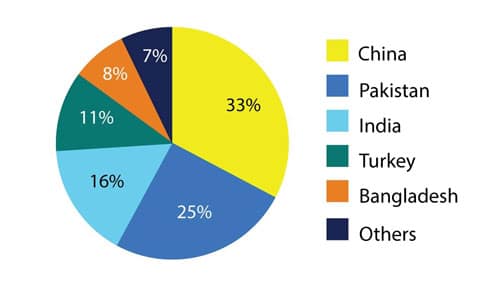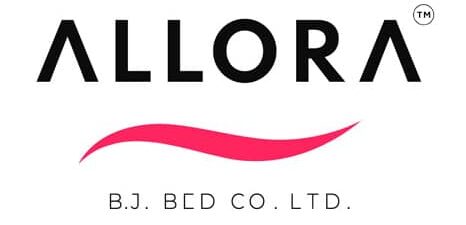Inside Bangladesh’s Home Textile Industry: Key Players, Trends & Opportunities
The home textile market in Bangladesh is experiencing strong growth due to rising consumer spending and increasing demand from consumers for decorating their homes as well as offices. The market is diversified with a range of quality products, and production of home textile products is rapidly increasing. This article offers an in-depth overview of Bangladesh’s leading home textile exporters, key market trends, emerging opportunities, and competitive advantages, highlighting why the country is well-positioned to become a global leader in home textile production.
Table of Contents
Eco-Friendly Materials Lead the Way in Sustainable Textile Production
Manufacturers like ALLORA are leading the charge in using natural fibers such as cotton, silk, linen, jute, soya, and bamboo instead of synthetic fibers like polyester, nylon, and olefin. Bangladeshi home textile manufacturers are very conscious about fashion creation and trends, which helps them gain a special place in the international market.
Why Bangladesh has the potential to become a major player in the global home textile market?
Bangladesh has the potential to become a major player in the global home textile market due to its skilled workforce, low production costs, and abundant natural resources like cotton and jute. The country’s growing focus on sustainable manufacturing, investment in modern technology, and improvements in worker safety and compliance have made it increasingly attractive to international buyers. With strong export-oriented companies and rising global demand for eco-friendly home textiles, Bangladesh is well-positioned to expand its footprint in the international market.
Asia Pacific: A Key Growth Region for Home Textiles
The Asia Pacific region is likely to show remarkable growth in the home textile market in recent times. Rapid urbanization, improved standard of living, and increasing spending power are the key factors anticipated to support the revenue. The demand for home textiles increased significantly from 2020 as people stayed home due to the COVID-19 pandemic. Despite this positive side, Bangladesh’s share in the global home-textile export market is only 7%.
Top 10 Export Players Driving Bangladesh’s Home Textile Success
Several leading companies are playing a pivotal role in establishing Bangladesh as a global hub for home textile exports. These manufacturers are known for their large-scale production, sustainable practices, and ability to meet international compliance standards.
-
ALLORA (Brand Of B.J. Bed Company): ALLORA specializes in eco-friendly and handcrafted textile products made from natural fibers, offering a wide range of Winter-ready Comforters, bed sheets, quilts, covers, pillows and other home textile products. The company is actively preparing for large-scale export, with target markets including the EU, UK, and North America.
-
Zaber & Zubair Fabrics Ltd. – Part of the Noman Group, this is one of the largest vertically integrated home textile producers in South Asia. Zaber & Zubair exports to major global retailers in the USA, Canada, Europe, and Australia.
-
ACS Textiles (Bangladesh) Ltd. – A UK-Bangladesh joint venture, ACS produces high-quality bed linens and home textiles. Its main export destinations include the UK, Germany, France, and Italy.
-
Saad Musa Group: A significant player known for innovation and quality in home textiles, offering a diverse product range catering to various market segments. They Export primarily to European countries, the United States, and Canada.
-
Alltex Industries Limited: A major contributor to textile exports with a diverse product line and established manufacturing capabilities ensuring consistent output and quality.
-
Mosharraf Group: Engages in large-scale production with a focus on custom textile orders, offering innovative home textile solutions. Strong brand recognition and a diverse product portfolio enhance customer loyalty and market penetration. Serves clients across North America, Europe, and the Middle East.
-
Apex Weaving: Specializes in advanced weaving techniques, producing a range of fabric types for home textiles. Integrates modern technology to improve production efficiency and offers tailored services to enhance customer engagement. Exports primarily to European countries, the United States, and Canada.
-
DBL Group: A diversified conglomerate with a significant presence in home textiles, DBL Group operates with vertical integration to enhance operational control. Robust supply chain management supports timely delivery and reliability, with investments in advanced production technologies. Exports to markets in North America, Europe, and Asia.
-
JK Group: Active in home textiles with a focus on sustainability and quality, JK Group operates a wide array of textile manufacturing processes. Strong financial backing facilitates investment in business growth, with efforts to develop niche markets through specialized textile designs. Serves clients in the United States, European Union, and Australia.
-
G.F Textiles Ltd: Provides a variety of home textile solutions with a growing export presence, focusing on both local and international markets. Diverse distribution channels ensure wide market accessibility, with collaborations with designers for unique collections. Exports to countries in Europe, North America, and the Middle East.
These key players are instrumental in driving Bangladesh’s export volume, enhancing product diversity, and meeting the increasing global demand for eco-conscious and stylish home textiles.
Rising Competition and Export Readiness in Bangladesh
The Bangladesh home textile market is becoming competitive with the presence of local players. ALLORA (Brand Of B.J. Bed Company), is preparing itself for export marketing as well. Bangladeshi home textile companies are focusing on restricting their businesses, developing work processes, and investing in product development. International manufacturers prefer setting up their manufacturing units in Bangladesh due to low labour costs and affordable raw materials.
Consumer Preferences Shift Towards Style and Comfort
The home textile market in Bangladesh is seeing growth due to several factors. First, rising consumer spending is leading to increased demand for home textiles. As people spend more on home décor, they want their homes to be as comfortable and stylish as possible. This leads to more demand for home textile products like bed sheets, duvets and pillow covers.
Work-from-Home Culture Boosts Office Textile Demand
Second, the increasing demand from consumers for decorating their offices has led to an expansion in the home textile market. With more people working from home due to the pandemic, the need for comfortable and functional office furniture has become a priority. This has led to increased demand for office furniture and home textiles such as desk chairs, office décor, and wall art.
Handcrafted and Eco-Friendly Products on the Rise
Third, the use of eco-friendly products and handcrafted items is an emerging trend in the home textile market. Consumers are becoming more environmentally conscious and want products that are sustainable and ethically made. Manufacturers like ALLORA Bangladesh are leading the charge in using natural fibers instead of synthetic ones. They are also using sustainable manufacturing processes and investing in product development to create eco-friendly home textile products.
COVID-19 Pandemic Accelerates Market Expansion
The Bangladesh home textile market’s growth has been accelerated by the COVID-19 pandemic. As people spent more time at home due to lockdowns, the demand for home textiles increased. With more people working from home, the need for comfortable and stylish home offices has also increased. This has led to an increase in demand for home textile products such as office furniture, curtains, and bed sheets.
Export Market Share Still a Challenge
Despite the positive growth in the home textile market in Bangladesh, the country’s share in the global home-textile export market is only 8%. However, the market is becoming more competitive with the presence of local players. Bangladeshi home textile companies are focusing on developing work processes, restricting their businesses, and investing in product development to gain a foothold in the international market.

Bangladesh as an Attractive Destination for Foreign Investors
International manufacturers prefer setting up their manufacturing units in Bangladesh due to low labor costs and alternative and cheap raw materials. This has led to an increase in foreign investment in the Bangladesh home textile market. With more international players entering the market, there is potential for the market to grow even further.
Focus on Innovation, Technology, and Sustainability
To increase their share in the international market, Bangladeshi home textile companies are focusing on developing their businesses and investing in product development. They are also investing in technology and research to improve their manufacturing processes, reduce waste, and produce eco-friendly products.
Competition with China and India: Bangladesh’s Strategic Edge
One of the challenges that the Bangladesh home textile market faces is competition from other countries like China and India. However, Bangladesh has several advantages over its competitors, such as a skilled workforce, low labor costs, and readily available raw materials.
Government Support and Labor Reforms Attract Global Interest
Moreover, Bangladesh has made significant progress in recent years to improve the working conditions of its workers in the textile industry. The government has implemented several initiatives to improve the safety and well-being of workers and has also increased the minimum wage for textile workers. This has helped to attract foreign investment and improve the country’s image as a reliable and responsible producer of textile products.
Conclusion: A Promising Future for Bangladesh’s Home Textile Industry
In conclusion, the Bangladesh home textile market is witnessing strong growth due to several factors, including rising consumer spending, increasing demand for home and office décor, and the growing popularity of eco-friendly and handcrafted products.
While Bangladesh’s share in the global home-textile export market is still relatively low, the market is becoming more competitive with the presence of local players and foreign investors. With its skilled workforce, low labor costs, and abundant raw materials, Bangladesh has the potential to become a significant global player in the home textile market.
The government’s continued focus on labor reforms and sustainability will further enhance the industry’s reputation and attract even more investment in the future.





